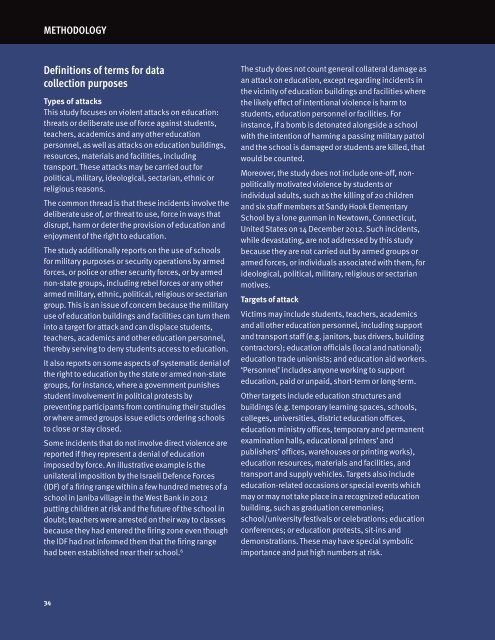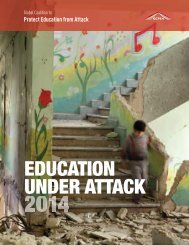You also want an ePaper? Increase the reach of your titles
YUMPU automatically turns print PDFs into web optimized ePapers that Google loves.
MeTHODOLOGYDefinitions of terms for datacollection purposesTypes of attacksThis study focuses on violent attacks on education:threats or deliberate use of force against students,teachers, academics and any other educationpersonnel, as well as attacks on education buildings,resources, materials and facilities, includingtransport. These attacks may be carried out forpolitical, military, ideological, sectarian, ethnic orreligious reasons.The common thread is that these incidents involve thedeliberate use of, or threat to use, force in ways thatdisrupt, harm or deter the provision of education andenjoyment of the right to education.The study additionally reports on the use of schoolsfor military purposes or security operations by armedforces, or police or other security forces, or by armednon-state groups, including rebel forces or any otherarmed military, ethnic, political, religious or sectariangroup. This is an issue of concern because the militaryuse of education buildings and facilities can turn theminto a target for attack and can displace students,teachers, academics and other education personnel,thereby serving to deny students access to education.It also reports on some aspects of systematic denial ofthe right to education by the state or armed non-stategroups, for instance, where a government punishesstudent involvement in political protests bypreventing participants from continuing their studiesor where armed groups issue edicts ordering schoolsto close or stay closed.Some incidents that do not involve direct violence arereported if they represent a denial of educationimposed by force. An illustrative example is theunilateral imposition by the Israeli Defence Forces(IDF) of a firing range within a few hundred metres of aschool in Janiba village in the West Bank in 2012putting children at risk and the future of the school indoubt; teachers were arrested on their way to classesbecause they had entered the firing zone even thoughthe IDF had not informed them that the firing rangehad been established near their school. 6The study does not count general collateral damage asan attack on education, except regarding incidents inthe vicinity of education buildings and facilities wherethe likely effect of intentional violence is harm tostudents, education personnel or facilities. Forinstance, if a bomb is detonated alongside a schoolwith the intention of harming a passing military patroland the school is damaged or students are killed, thatwould be counted.Moreover, the study does not include one-off, nonpoliticallymotivated violence by students orindividual adults, such as the killing of 20 childrenand six staff members at Sandy Hook ElementarySchool by a lone gunman in Newtown, Connecticut,United States on 14 December 2012. Such incidents,while devastating, are not addressed by this studybecause they are not carried out by armed groups orarmed forces, or individuals associated with them, forideological, political, military, religious or sectarianmotives.Targets of attackVictims may include students, teachers, academicsand all other education personnel, including supportand transport staff (e.g. janitors, bus drivers, buildingcontractors); education officials (local and national);education trade unionists; and education aid workers.‘Personnel’ includes anyone working to supporteducation, paid or unpaid, short-term or long-term.Other targets include education structures andbuildings (e.g. temporary learning spaces, schools,colleges, universities, district education offices,education ministry offices, temporary and permanentexamination halls, educational printers’ andpublishers’ offices, warehouses or printing works),education resources, materials and facilities, andtransport and supply vehicles. Targets also includeeducation-related occasions or special events whichmay or may not take place in a recognized educationbuilding, such as graduation ceremonies;school/university festivals or celebrations; educationconferences; or education protests, sit-ins anddemonstrations. These may have special symbolicimportance and put high numbers at risk.34



